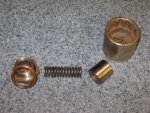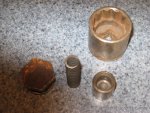This is something that has been touched on in past threads on spin on filter adapters. This is dealing with the bypass valve that bypasses the oil filters when there is a differential of 15psi caused by dirty filters or whatever. There has been some conjecture that the filters are bypassed even with clean filters at highway RPMs. The goal of course being to make sure the oil is going through the filters unless there is really a reason they should be bypassed. This is the plug located on the filter base below and between the filter cans. It is not easy to remove due to tight clearances, and the fuel lines being in the way.
****THIS THREAD IS NOT ABOUT BYPASS FILTERS**** I know there has been considerable confusion in past threads between “bypass filters” and “bypass valves”.
As you can see from the pics the bypass valve has three parts. The threaded plug (Which is the same plug as you oil drain plug.), a spring and plunger. The simple way of increasing the PSI needed to activate the bypass valve is to add a shim inside the threaded plug to increase the spring pressure. A simple washer should would just fine for this. The real question is how thick of a shim is needed to increase the spring pressure a reasonable amount. I found some old sockets I hope to machine down to fit on the threaded plug head.
****THIS THREAD IS NOT ABOUT BYPASS FILTERS**** I know there has been considerable confusion in past threads between “bypass filters” and “bypass valves”.
As you can see from the pics the bypass valve has three parts. The threaded plug (Which is the same plug as you oil drain plug.), a spring and plunger. The simple way of increasing the PSI needed to activate the bypass valve is to add a shim inside the threaded plug to increase the spring pressure. A simple washer should would just fine for this. The real question is how thick of a shim is needed to increase the spring pressure a reasonable amount. I found some old sockets I hope to machine down to fit on the threaded plug head.
Attachments
-
217.3 KB Views: 372
-
195.7 KB Views: 373
-
188 KB Views: 375





